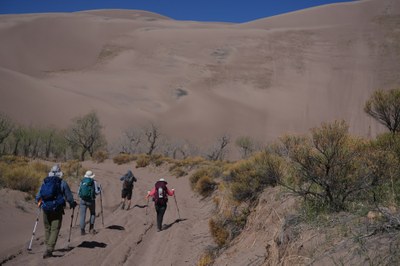
Trip Report
BPX Trip – 3-Day Great Sand Dunes Backcountry from Point of No Return TH
Fun adventure backpack to the Great Sand Dunes. Camped 2 nights at a designated backcountry site and did exploring in the backcountry, on trail and road, and in the popular day use area.
- Sun, May 19, 2024 — Tue, May 21, 2024
- BPX Trip – BPX 3-Day: Great Sand Dunes Backcountry from Point of No Return TH
- BPX 3-Day: Great Sand Dunes Backcountry from Point of No Return TH
- Backpacking
- Successful
-

- Road suitable for all vehicles
-
Biggest takeaway: almost all of your hiking in this national park will be on sand. With a full pack, this is much harder than on solid ground. Don’t underestimate how tough this will be for your group.
The winds were very high, which is not unusual for the park. Sand and wind and awesome views await you!
We got a permit for and camped at the designated backcountry site Little Medano. We were assigned parking at the Horse Trailer lot, which made for a 5.75 mile hike to camp along the Sand Ramp Trail from the Pinon Campground. The park service assigns parking areas based on your selected campsite. Sites that are farther out than Little Medano can park closer in along the Medano Pass primitive road at (small) parking areas, but you must have high clearance 4WD. AWD is not permitted. To drive to those parking spots, you have to cross two creeks with your vehicle. The road to the horse trailer lot is paved. After that, it is not. You will see trailheads on the map that are beyond the Horse Trailer lot–you can’t drive to those without high clearance 4WD, and you can only park at them if you have campsites Aspen, Cold Creek, or Sand Creek.
You can hike to the backcountry sites along the road or the Sand Ramp Trail (depending on your site. For Buck Creek and Escape Dunes sites, the trail is the only approach). Both the trail and road are very sandy and soft. This makes hiking with a full pack challenging, even though the mileage and elevation gain (depending on your site) might not be great in number. I would consider the hike to any of the sites AFTER Escape Dunes to be moderate to difficult because of the sandy terrain plus distance. Hikers must have good footwear and be prepared for slow going on soft surfaces, with the potential for ankle, knee, and hip issues. Poles are recommended.
Water is variable in the backcountry here. Medano Creek, which is a half mile from the Little Medano campsite, is usually a reliable year-round water source. That half-mile is sandy and requires a hill climb, so you won’t want to do it repeatedly. Bring large water reservoirs. When we did the trip, the Little Medano Creek was running, but this is a seasonal spring creek. It is .3 mile north from the Little Medano campsite. That walk is also sandy with a hill. Water sources for the other campsites vary and you might need to do larger, less frequent water carries. Research this well before you go.
Details from our trip: We found the Little Medano campsite to be in a lovely, secluded spot well off trail in a woodland of giant ponderosas. It is shaded, and has views of the mountains. You cannot see the sand dunes from camp, or get to them easily. If you want to do night-time star gazing on the dunes, this might not be the best site. You can get onto the dunes quickest from Little Medano by going north on the trail, over LIttle Medano creek, and up the dunes on the other side. We enjoyed the spot, the epic adventure and views we had, and each other's company. We saw deer, chipmunks, and a turkey. We found the sandy terrain to be taxing, but spirits were high throughout.
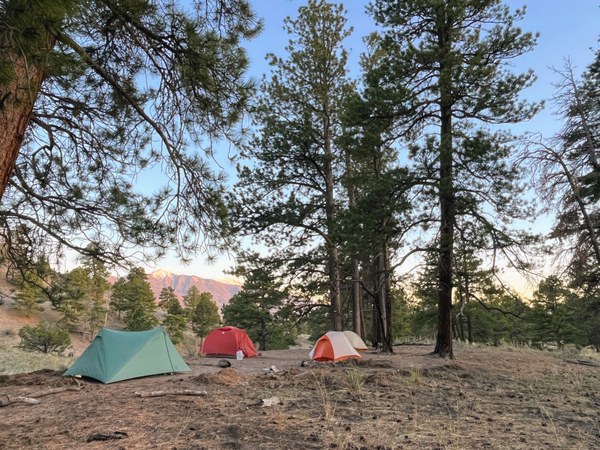
We managed to see a lot of the park that the typical visitor does not see. There were very few people outside the day use area right by the visitor center, while we got to see the dunes and mountains and transitional desert/woodlands zones all along the eastern edge of the park.
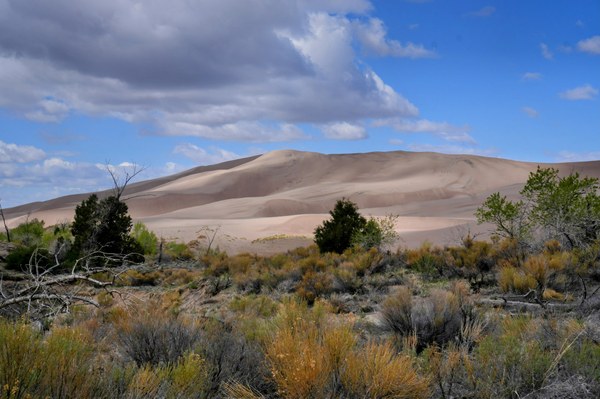
- Day 1: Arrived, stopped at the visitor center to buy souvenirs and ask the ranger for any updates on the trail, site, etc. Then we parked at our assigned spot and hiked to camp along Sand Ramp Trail (5.75 miles, 735 feet)
- Day 2: hiked down trail to the 4WD road and hiked the road 2.8 miles to the south to a lovely spot where the road bends towards the dunes, just north of Castle Creek picnic area. By going off road toward the dunes, we found a spot where Medano Creek runs along the bottom of the dunes and there was a little beach area and break in the trees where we picnicked and played in the creek. If you go a little farther south, you reach a day use picnic area called Castle Creek with more beaches, good dunes views, and pit toilets. You can climb onto the dunes here if you like. After our picnic, we took the road back to camp, rested, and then explored north on the Sand Ramp Trail, exploring the top of the dunes at the north end, where the dunes run into the mountains. No one was out there, it was a neat and different perspective of the dunes.
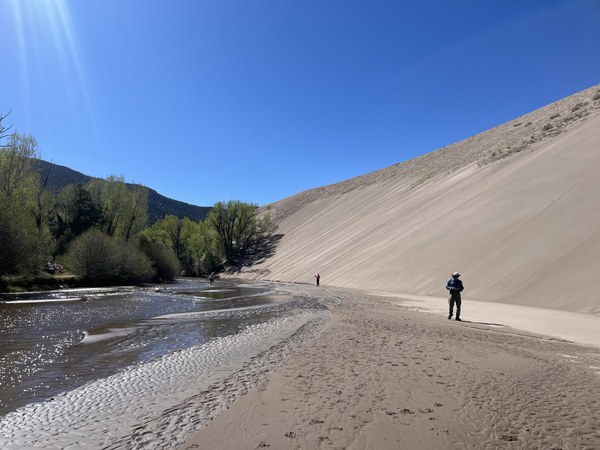
- Day 3: Broke camp, hiked the road all the way back to the day use area, moved our car to the Dunes Picnic Area parking, and went into the spot that is most popular for park visitors. This area has expansive dune views, and is where the seasonal spring flow of Medano Creek across the sand is most awesome. People had beach setups with their families all over here. You can cross the creek and then a wide flat sand area to the dunes, and climb the dunes here. We were tired of hiking on sand and didn’t do that, but we enjoyed the views and seeing people climb the dunes, even to the top of the high dune which looked very challenging from below. We then went to the visitor center to change clothes and head out.
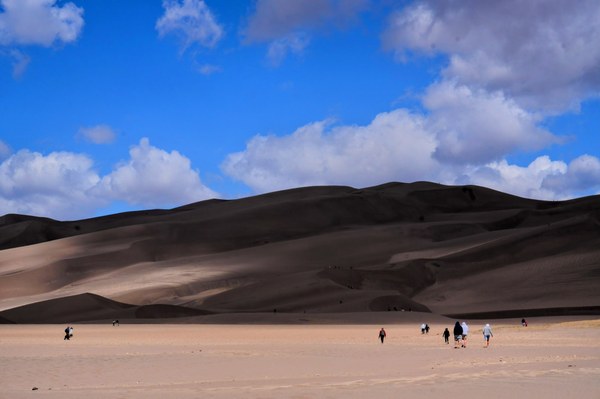 Things I would do next time: Hike the road to camp, stopping for a picnic at Castle Creek picnic area and enjoying this special spot along the creek at the foot of the dunes. Then head to camp. Then on Day 2, I would hike north from camp and explore the dunes at the north end of the park, potentially doing some overland travel on the dunes and then navigating back to the trail and taking it to the high point before it drops down to the Cold Creek campsite. I would do the Dunes Picnic Area on the third day before departing, as we did. If you want to seriously climb the dunes, and perhaps aim for the High Dune, I would do the Dunes Picnic Area on Day 1, with an early start, and camp closer to the visitor center area, at Buck Creek or Escape Dunes, so the approach to camp after spending the morning on the dunes would be shorter. We were too tired just from hiking on the trail and road to spend any real time on the dune themselves.
Things I would do next time: Hike the road to camp, stopping for a picnic at Castle Creek picnic area and enjoying this special spot along the creek at the foot of the dunes. Then head to camp. Then on Day 2, I would hike north from camp and explore the dunes at the north end of the park, potentially doing some overland travel on the dunes and then navigating back to the trail and taking it to the high point before it drops down to the Cold Creek campsite. I would do the Dunes Picnic Area on the third day before departing, as we did. If you want to seriously climb the dunes, and perhaps aim for the High Dune, I would do the Dunes Picnic Area on Day 1, with an early start, and camp closer to the visitor center area, at Buck Creek or Escape Dunes, so the approach to camp after spending the morning on the dunes would be shorter. We were too tired just from hiking on the trail and road to spend any real time on the dune themselves.
 Lisa Shroyer
Lisa Shroyer